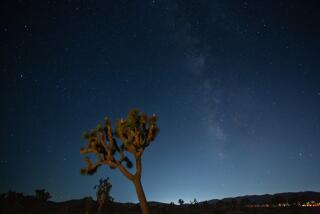Exciting Pictures of Winter World
- Share via
Photographers can find winter images all year in at least some part of the world and at high altitudes. A few basic rules can make these images as visually exciting as your spring and summer photos.
When taking photographs of snow scenes, be careful if you are using an automatic exposure camera. Backgrounds with large expanses of snow can cause underexposure or darkening of people and other subjects in the foreground. Use the exposure lock to read the area of major interest before tripping the shutter.
Bright Colors
Bright colors such as red can add a touch of interest to a picture taken on a cold, gray day. Have your family (or models) wear brightly colored sweaters, scarfs and stocking caps.
Sunny winter days can create dark facial shadows. These can be eliminated by the use of flash-fill or even a tinfoil reflector. To make your own reflector, paste or tape some kitchen tinfoil to a large piece of flat cardboard.
The romantic glow of the ski lodge fireplace lasts a long time in your visual memory. When you bundle up to go outside with your camera, however, your body cools off quickly. Dress warmly for your own comfort. You need to function at least as well as your cameras.
Thermal underwear is a good idea. Wear a stocking cap that covers your ears. Don’t choose a hat with a brim or visor that will get in your way when lifting a camera strap over your head. Wear gloves that allow digital dexterity.
Layered Clothing
Layered clothing is effective and lets you take layers off if the day gets warmer. I wear a photographer jacket with one or two wool sweaters underneath. The deep pockets carry extra film and lenses, and the hood goes over a stocking cap.
Wool socks and comfortable shoes with rubber galoshes or rain boots will keep your toes warm. Sunglasses and sunscreen will protect you from snow glare and sunburn.
As you leave the fireplace of the ski lodge, your cameras are also warm, and taking them directly outside into sub-zero temperatures may cause some condensation on both metal and glass surfaces. It is best to let the cameras and lenses cool off gradually.
Camera batteries do not function well when they become very cold. You can keep them warm by carrying your camera under your coat, making use of your body heat.
Glacier Express
Among less athletic ways of getting spectacular winter photographs, Swiss Railways has introduced an all-day excursion on the Glacier Express that will give you one breathtaking panorama after another on the way between Zermatt and St. Moritz.
An added advantage for the photographer is that the windows of the relatively luxurious train can be opened when you are taking pictures. Don’t be tempted to pack a lunch box; for about $12 you can have a truly gourmet dining experience on the Glacier Express.
Cable cars in any country have the disadvantage that their windows do not open, but they usually deposit you at a spectacular vantage point for winter photos. You will want a zoom lens, perhaps an 85-210 millimeter, to pick out individual houses or people on the hillsides.
Reflecting Light
Winter shots can be very effective. Look for light reflecting on ice-covered surfaces. Put the sun behind icicles and frozen tree branches. Take night photographs in cities when frozen surfaces become mirror reflections of colorful neons and traffic lights.
When the snow really starts to fall, take your camera out and get into the thick of it. City lights, people and even traffic are transformed. You can protect your camera with a clear plastic bag covering everything but the lens.
It’s not hard to take photos in the winter. Just pack a warm coat and some thick socks, and go looking for some cool pictures in the tall mountains or northern latitudes.
More to Read
Sign up for The Wild
We’ll help you find the best places to hike, bike and run, as well as the perfect silent spots for meditation and yoga.
You may occasionally receive promotional content from the Los Angeles Times.






